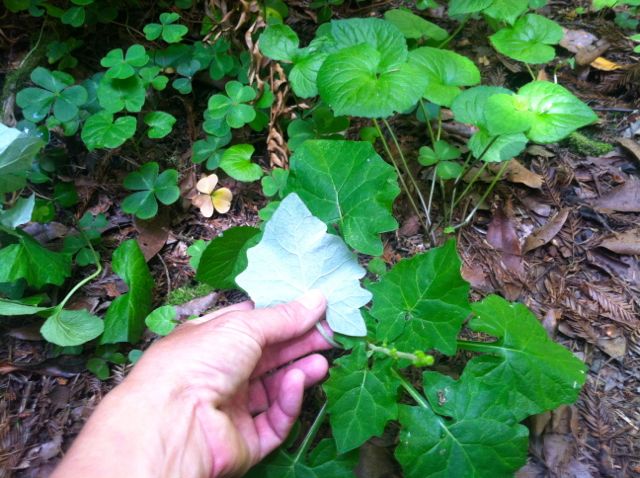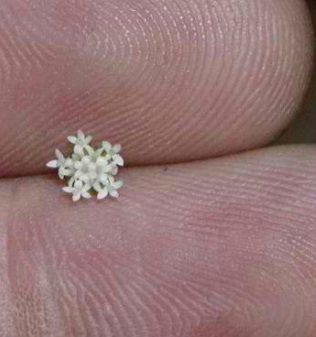|
After the Mendocino Wildflower Show this weekend I was inspired to hike the redwood forest to look for some of my favorite forest dwelling wildflowers and plants. Today we feature the Trail Plant (also called Pathfinder Plant), or Adenocaulon bicolor. When their dark green, triangular leaves are disturbed or turned over their bright, white under-leaf is displayed and one can easily follow the trail of another passing through the woods or mark their own way with it's leaves. How cool is that??
The trail plant is a perennial that regenerates each year, forming what appears to be a low hovering mat of leaves in the shadowed areas under trees and along fallen logs or trails. Their big leaves allow moisture to collect under them along the forest floor and duff which helps to decompose organic matter. In addition to their leaves, there is a single slender stem that shoots up to about three feet tall that extends out to tiny white flowers that make their appearance from June to September. The tiny fruit that grows at the end of the stem have tiny hairs that cling to pant legs to be transported through the forests.
0 Comments
Scratch first, itch later - Zen Proverb Here, along the coast of Northern California one easily sees the importance of these sand formations - whenever you see a sand dune - you know you are in an area that needs the protection of those very dunes. This particular beach takes on heavy winds all the time - in this photo I took, you can easily see how this linear dune protects this highly sensitive bluff. Also, when the beach itself is ravaged by storm surge in the winter months, these very dunes will provide a necessary reservoir of sand for this coastal region. Not only are sand dunes critical to the environment and ecology of the region, they are also spectacular to see - I am always awed by their smooth lines and curvatures along such a wind driven and active coast line.
So, what are sand dunes???? As sand accumulates on a beach area, several forces work together to move deposited sediments inland, where they form dunes. Waves continue to push sand up onto the shore, and winds carry dry sand away from the water. Eventually, piles of this sand become contained and fortified by various grasses, shrubs and other coastal vegetation. These piles of sand are known as coastal sand dunes. Sand dunes also provide a foundation for ecosystems made up of a wide variety of coastal life. Rodents carve out extensive burrows and vegetation and insects of all kinds have adapted to live in a dune's sandy environment. These dunes are just one of the many incredible sights to see when visiting this region... so when you come up to Northern California give Unbeaten Path a call and let us show you something unforgettable! It is not often that I see the Red-Bellied Newt or Taricha Rivularis. However, on our last tour, following some morning rains, while walking in the redwoods we had the pleasure of seeing one. I love them.... they have character, are elusive and are just cool to see. It is amazing how well they blend into the forest floor. The Red-bellied newts are considered to be creatures from the fire and you can see why people believed this. Their skin looks almost charred and their fire-like, tomato-red under belly is just stunning! This feature, and their lack of yellow colored eyes, is what makes the red-bellied newt distinguishable from the others. They are native to the coastal woodlands in Northern California. They measure (when full grown) up to 3.5 inches. Newts begin their lives as aquatic larvae similar to tadpoles. We saw an adult on the trail - it calmly walked under a redwood log once it realized it had been spotted by intruders (us). At first, it was unmoving and it blended miraculously into the forest floor. Just amazing! We couldn't get our cameras out fast enough (and I am pretty quick on the draw). When disturbed, the red-bellied newts pull their heads and tails back to reveal their bright-red undersides. This serves as a warning to potential predators, as red-bellied newts have enough of a neurotoxin, tetrodotoxin, in their skin to easily kill an adult human, or 7,500 mice. SO DO NOT EAT THESE GUYS! and do not touch. And the coolest thing: Like other newts, red-bellied newts have the ability to regenerate several body parts, including their limbs, eyes, hearts, intestines, and upper and lower jaws, and damaged spinal cords. IF ONLY WE COULD DO THAT! |
AuthorMadge Malone in her blogging zone! Categories
All
|






 RSS Feed
RSS Feed